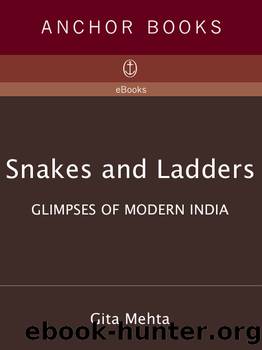Snakes and Ladders by Gita Mehta

Author:Gita Mehta [Mehta, Gita]
Language: eng
Format: epub
ISBN: 978-0-307-76623-6
Publisher: Knopf Doubleday Publishing Group
Published: 2012-04-04T00:00:00+00:00
Nonviolence
In 1978 an Indian magazine asked me to go to the northeastern border state of Assam, home to twenty million people, and write about the largest nonviolent movement India had seen since Mahatma Gandhi had used nonviolence to end the British Raj.
Nonviolence may have expelled the British from India, but our first lesson in freedom was the violence of Partition and in Assam I discovered we have not yet learned our lesson well.
It was dusk when I reached the capital of Assam and drove to the hill temple that is Assamâs holiest place of pilgrimage. With its rice fields stretching to Bangladesh on one side, its wooded hills rising to Chinaâs borders on the other, Assam is connected to India by only a narrow corridor of land. But the attempt to capture Indiaâs attention had mobilized hundreds of thousands of Assamese into a nonviolent movement that had already closed schools, factories, shops, and Indiaâs major oil refinery for nearly a year.
Standing on the hillside high above the mighty Brahmaputra River, I tried to understand this movement whose ranks swelled daily with newcomers prepared to defend what tourist brochures called âThe Land of the Red River and the Blue Hills.â
In the temple courtyard a frangipani tree dropped white blossoms onto the black stones, the slender petals spinning like hexagons against the darkening sky. Below the temple, the setting sun was throwing the islands in the vast sweep of water into red relief. River steamers from the days of the British Empire, still bearing their battered old JARDINE HENDERSON signs, crossed the crimson water of the great river as mist closed over the fishing villages on the distant bank. Inside the temple the priest had begun the evening devotions, chanting a melancholy melody that seemed to evoke Assamâs separation from the rest of India.
We had done little to dispel that sense of isolation. In 1962, when the Chinese Army had invaded India through Assam, Prime Minister Nehru had withdrawn our ill-equipped troops from the occupied state with his infamous radio address, âMy heart bleeds for the people of Assam.â
Then in 1971 the war for the new nation of Bangladesh had pushed waves of war-weary refugees over Indiaâs borders into Assam. They were still there, and the Assamese were demonstrating against what they considered a new occupation. But Prime Minister Indira Gandhi had declared the movement the work of foreign agitators and sent in the Indian Army to disband the protesters and open the oil refinery.
So I could sympathize with the angry young engineer who had asked me, âWe are fighting another invasion, and Nehruâs daughter sends the Army to fire on us! Is she mad? Is it our fault that the millions of foreigners who are overrunning us today donât speak Chinese?â
But as I watched the lanterns swaying on the steamers far below me and the river turning black in the fading light, I wondered how long Assamâs movement to expel foreigners would limit itself to foreigners. How long before it turned
Download
This site does not store any files on its server. We only index and link to content provided by other sites. Please contact the content providers to delete copyright contents if any and email us, we'll remove relevant links or contents immediately.
| China | India & South Asia |
| Japan |
Fanny Burney by Claire Harman(25795)
Empire of the Sikhs by Patwant Singh(22188)
Out of India by Michael Foss(16317)
Leonardo da Vinci by Walter Isaacson(11927)
Small Great Things by Jodi Picoult(6111)
The Six Wives Of Henry VIII (WOMEN IN HISTORY) by Fraser Antonia(4801)
The Wind in My Hair by Masih Alinejad(4430)
The Lonely City by Olivia Laing(4133)
The Crown by Robert Lacey(4118)
A Higher Loyalty: Truth, Lies, and Leadership by James Comey(4044)
The Iron Duke by The Iron Duke(3655)
Millionaire: The Philanderer, Gambler, and Duelist Who Invented Modern Finance by Janet Gleeson(3577)
Sticky Fingers by Joe Hagan(3459)
Alive: The Story of the Andes Survivors by Piers Paul Read(3324)
Papillon (English) by Henri Charrière(3283)
Joan of Arc by Mary Gordon(3272)
Stalin by Stephen Kotkin(3094)
Aleister Crowley: The Biography by Tobias Churton(3030)
Ants Among Elephants by Sujatha Gidla(2930)
